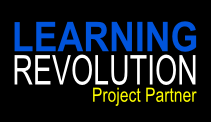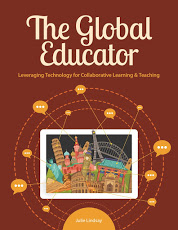Scott McLeod, J.D., Ph.D. Ames, Iowa, USA
Blog: http://www.dangerouslyirrelevant.org
Bio: Scott McLeod, J.D., Ph.D., is an Associate Professor and Coordinator of the Educational Administration Program at Iowa State University. He also is the Director of the UCEA Center for the Advanced Study of Technology Leadership in Education (CASTLE), the nation’s only center dedicated to the technology needs of school administrators.
Bio page: http://k12online08presenters.wikispaces.com/Scott+McLeod
Presentation Title: Current leadership models are inadequate for disruptive innovations
Description: In this 20-minute voice-narrated PowerPoint (Presentation Zen style) Dr. McLeod reflects upon key concepts from Dr. Clayton Christensen’s work regarding disruptive innovation. The presentation draws primarily from two of Dr. Christensen’s books, The Innovator’s Dilemma and Disrupting Class, and focuses on the different ways of thinking that are now mandatory if school leaders are to successfully navigate their organizations in transition to the 21st century. Key points from other leadership models also make their way into the presentation.
Presentation
Link on dotsub
About transcribing/translating this video
Download
Original (21:01 Run Time; wmv, 34.3 MB)
iPod Video (21:01 Run Time; mp4, 25.3 MB)
Audio only (21:01 Run Time; mp3, 6.9 MB)
Supporting Links
http://www.dangerouslyirrelevant.org/2008/10/can-a-computer.html
http://www.dangerouslyirrelevant.org/leadership.html
Essential Questions
Access Help Desk
[tags]k12online08lc03, k12online08[/tags]








I have been waiting for the podcast since I saw that it was posted! This really made me think and I may be confused now more than ever. The main point that kept coming to mind is how slow school are move toward technology advances. Time and money being the biggest factors. Not that we should or can use these as excuses but they are out there.
Thanks for the comment, Melinda. One of the big takeaways for me from Christensen’s work is that HOW we move toward technology advances is as important as IF we move toward technology advances. And most schools are going about it wrong because they’re trying to retrofit disruptive technologies into the current system. That almost never works because the system was set up for a different purpose.
http://www.diigo.com/annotated/0d60be42bda141d665628f7f6c8bd326
A new teacher shared this article today. It is very applicable.
Seems like we can get so busy filtering internet, banning social networks, and enforcing cellphone and ipod policies…..so busy we can’t stop to think of the educational potential. These are the disruptive innovations in my mind…and its easy to see why it is less of a struggle to start over than to change an organization.
Thanks for starting the conversation.
Thanks for a very informative presentation! I plan on reading both of those books and sharing this information to the organization that I work with. I have a quote hanging in my office that says “If you don’t like change, you’re going to like irrelevance even less.” Sums it up well, I think. Thanks for helping me not become irrelevant by providing me with the tools for change.
Great presentation! A disruptive innovation has a strangely ominous yet progressive ring to it. I hope education does not go the way of the eight track, but like the mobile phone, flourishes into a more accessible and equitable system.
I believe the Christensen’s book, Disrupting Class, is perhaps the most important book on education that I have read in the last decade. Thanks, Wesley, for doing a fine job summarizing it. I hope that it will lead to a wider audience but more importantly, to a wider and deeper discussion about the changing role of educators.
There are those who might argue that the current system of public schools in this country is so broken that almost any change is better than what we have, I am not convinced. Christensen’s book is largely silent, for example, on the many other roles that schools play in socializing youth, providing for co-curriculuar activities, and – let’s face it – child care facilities for working parents.
I look forward to the conversation…
Pingback: The week that was - Clayton Christensen
Steve: I have been the convener for the “Leading the Change” strand, but I am not the presenter nor can I claim any of the credit for the fantastic ideas in this presentation. All that credit belongs to Dr. Scott McLeod— and I agree, he has done a great job summarizing these ideas. I have not YET read either of Christensen’s books but that is going to change over the upcoming holidays! I heard Bob Sprankle reference Christensen’s book as the most important one he’s read since Friedman’s “The World is Flat,” and with accolades like that (as well as yours and Scott’s) it would be foolish to NOT read it and turn over his ideas in even greater detail than Scott has been given time to do in this 20 minute presentation. This was a great overview and introduction to these ideas and has inspired me to learn more.
Pingback: The Energy to Focus on Change | always learning
Scott,
Thank you for the inspiration today! I have been mulling some ideas around in my head for a couple of months, and your presentation as well as a blog post by Dean Shareski got me motivated … the result is here:
http://www.ncs-tech.org/?p=1984
Would love your thoughts and comments!
Best, kj
You are brilliant! It was great to hear your voice and your presentation of Christensen’s ideas. I am preparing my slide show for our school committee tomorrow night. Here is my last slide I am leaving them with.
I wrote this before I listened to your movie and now I am sure I will present this information. “It has been predicted that by 2014 25% of students will be taking online classes. At first I thought this was silly, but now already in WOCSD we are demonstrating how this happens.
By offering online computer instruction we have engaged students in activities at their level of instruction AND we have freed up the teacher to work with smaller groups of students or with individuals.
So…. in 2008-2009 in WOCSD we have over 50% of our students able to access an online piece of instruction.”
Presentation to Wells Ogunquit School Committee, November 2008, Cheryl Oakes
Thanks, everyone, for the kind words about the presentation. Some questions that are kicking around my head:
1. Assuming the natural laws of disruptive innovation apply here too, will the monopoly position of K-12 schools hasten or delay the move to a different system?
2. Will extracurriculars, athletics, and the need for student ‘babysitting’ ensure that schools always will exist?
Another important aspect of the potential change by 2019 is that universities are already embracing this disruptive change. It is not impossible to imagine that universities will accept virtual high school transcripts much in the same way they are accepting portfolios from home-schooled children.
It is easy to imagine secondary schools as personal learning centers where the collective resources of a district and the collective knowledge of a faculty will be coupled with the collective understandings of the world to produce an innovative and exciting place to learn (see The Met in Providence, RI as an example). As an administrator who has been thwarted in his attempts at changing this age-old institution this presentation has only confirmed my belief that we need to push for innovation for the greater benefit of our students. Thank you for this insightful discussion!
@Steve Taffee: I agree that schools’ current roles regarding co-curriculur activities and child care for working parents are important ones. But schools’ primary purpose is supposedly academic and it’s increasingly clear that other ways are emerging to address that. If our best argument for schools is sports, clubs, and babysitting, I don’t think that’s a very strong one. I’m most worried about the socialization issue – see, e.g., http://snipurl.com/narrowcast – but mechanisms to address this also may emerge. It’s just so hard to discern what it all will look like 20, 30, 40 years from now…
@Jeffrey Burt: Yes, it will be interesting to see what kind of influence postsecondary institutions’ use of online learning will have on P-12!
Pingback: GaETC: School Change and Technology « Georgia Library Media Association
Pingback: Innovation in Education | Finding Common Ground
Pingback: barcamping on plymouth rock « Higher Edison
Pingback: Study Ideas and Thoughts » Blog Archive » Disrupting Professional Development
This video was very interesting. I am currently at a school that has problems with technology. Kids are texting but not really have the assess to the computer and other helpful technology. Kids immediately go to Myspace and facebook instead of doing work. Somehow they have learned how to pass the firewall.
Dr Mcleod-
You talk extensively about organizations that, while they continue to do the right thing, eventually fail when the disruptive technology eventually becomes “good enough” and takes over. What is your view of companies that were successfull at making the switch, such as Nikon. If Nikon was able to make the switch within the company, what would this imply for school?
Hi Ryan,
Thanks for the comment. A couple of questions:
1) Has Nikon successfully made the switch? What’s their market share compared to before? Was it / is it one of the leading companies in what it does?
2) Assuming it has successfully made the transition, it would be interesting to see what Nikon has done (I have no idea). IBM, for example, had to set up a separate unit outside of itself that was more nimble and had more autonomy than the rest of Big Blue.
I don’t know how many dominant companies, faced with a disruptive innovation, have remained the market leader in the new environment. Christensen’s own research on leading companies seems to indicate extremely few…
Pingback: Disrupting Education - Thing 13 | Technology in Education
Pingback: Effective Leadership in an Era of Disruptive Innovation by Scott McLeod » Moving at the Speed of Creativity
Pingback: Amy’s Tech Integration
Pingback: Disruptive Innovation != The Inevitable March of Progress « iThinkEducation.net!
Pingback: Thing 13…the Survival of Fryeburg Academy | FA Honors Bio
Pingback: Inciting disruption | All Hands on Deck
Pingback: Reader, Reader, Pumpkin Eater -Thing 7c | Wait, Can You Repeat That?
Pingback: Going 1:1: Top 5 Insights from ASB Unplugged | always learning
Pingback: International Schools, Disrupted | always learning
I am in support of the this article regarding disruptive innovation, and I can see how the school systems will have to modify its systems to compete in the 21st Century, and focus on personal education.
Pingback: Thing 13 | Urban Mathematics in the 21st Century Classrooms
Very interesting presentation. It suggests to me that when we look to putting technology in schools, sometimes it’s better to wait for the next iteration of devices and software than to just buy the latest thing out on the market. Consider, mobile devices, which have been around for awhile in schools. The first few generations of these products, while innovative, did not reach the threshold of “good enough” to break through to mainstream adoption. Now we are starting to see mobile devices which offer enough benefits for learning that we may compare and contrast them with desktops and laptops as viable alternatives. Making the case for the transition in schools is a challenge as you indicated.
Thank you for the presentation!
Thank you for this presentation.
This is happening right now with mobile devices, which are just starting to break through the “good enough” threshold for mainstream adoption in schools.
The popularity of the iPad and other handheld devices suggests that we are experiencing disruptive innovation as it relates to our personal technology, and this will begin to affect institutions and schools more and more over the next several years.
Pingback: ED554 Weekly Diigo Links « ED554 Summer 2011
Pingback: ED554 Bookmarks (weekly) « ED554@Reston
Pingback: Disrupting Professional Development | Ideas and Thoughts
Pingback: The week that was | ClaytonChristensenInstitute